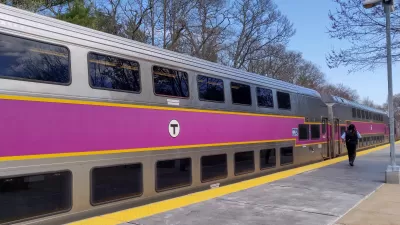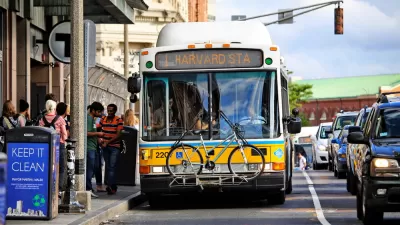A closer look at commuting and ridership shows the differences between urban and suburban transit patterns.

Alon Levy of the Pedestrian Observations blog compares commuter ridership on urban transit and commuter rail. He finds that in San Francisco the total number of riders on four parallel east-west Muni bus routes serving the central business district is almost twice the maximum number of commuters:
This represents an implausible 184% mode share, in a part of the city where a good number of people own and drive cars, and where some in the innermost areas could walk to work. What’s happening is that when the transit system is usable, people take it for more than just their commute trips.
He then looks at the Massachusetts Bay Transportation Authority’s regional rail and riders coming into Boston’s CBD from suburbs and city neighborhoods near rail. Levy finds the mode share to be just 32 percent, and he notes that most commuters use other modes and very few commuter rail passengers are using rail for other non-work trips.
The difference between San Francisco and Boston is partly due to the geographic distribution of the non-work places people need to reach for shopping, errands, and services. In a city, travelers can use transit to reach these locales, but they are more likely in the suburbs to drive to them.
Levy also says that regions with transit systems that cater to commuters — trains arriving once an hour during off-peak hours, for example — will not be able to attract other types of riders. "If the station placement is designed around car travel, as is the case for all American commuter lines and some suburban rapid transit (including the tails of BART), then people will just drive all the way unless there’s peak congestion. Only very good urban transit can get this non-work ridership," he says.
FULL STORY: Urban Transit Vs. Commuter Transit

Alabama: Trump Terminates Settlements for Black Communities Harmed By Raw Sewage
Trump deemed the landmark civil rights agreement “illegal DEI and environmental justice policy.”

Planetizen Federal Action Tracker
A weekly monitor of how Trump’s orders and actions are impacting planners and planning in America.

The 120 Year Old Tiny Home Villages That Sheltered San Francisco’s Earthquake Refugees
More than a century ago, San Francisco mobilized to house thousands of residents displaced by the 1906 earthquake. Could their strategy offer a model for the present?

In Both Crashes and Crime, Public Transportation is Far Safer than Driving
Contrary to popular assumptions, public transportation has far lower crash and crime rates than automobile travel. For safer communities, improve and encourage transit travel.

Report: Zoning Reforms Should Complement Nashville’s Ambitious Transit Plan
Without reform, restrictive zoning codes will limit the impact of the city’s planned transit expansion and could exclude some of the residents who depend on transit the most.

Judge Orders Release of Frozen IRA, IIJA Funding
The decision is a victory for environmental groups who charged that freezing funds for critical infrastructure and disaster response programs caused “real and irreparable harm” to communities.
Urban Design for Planners 1: Software Tools
This six-course series explores essential urban design concepts using open source software and equips planners with the tools they need to participate fully in the urban design process.
Planning for Universal Design
Learn the tools for implementing Universal Design in planning regulations.
Clanton & Associates, Inc.
Jessamine County Fiscal Court
Institute for Housing and Urban Development Studies (IHS)
City of Grandview
Harvard GSD Executive Education
Toledo-Lucas County Plan Commissions
Salt Lake City
NYU Wagner Graduate School of Public Service





























